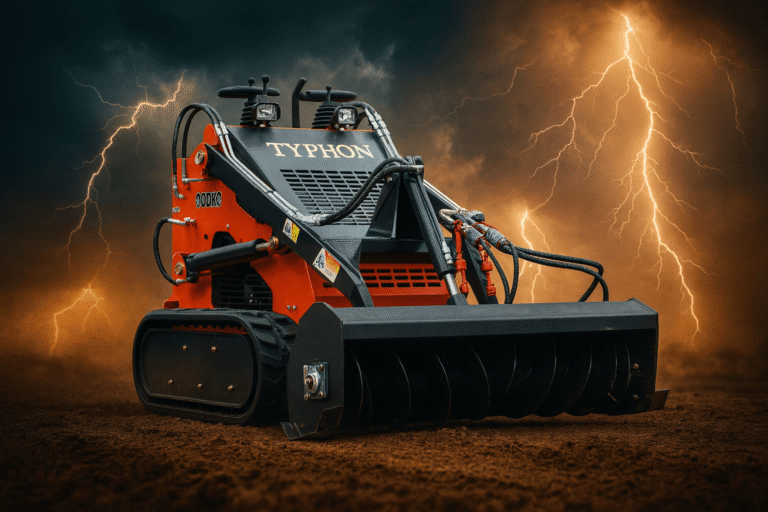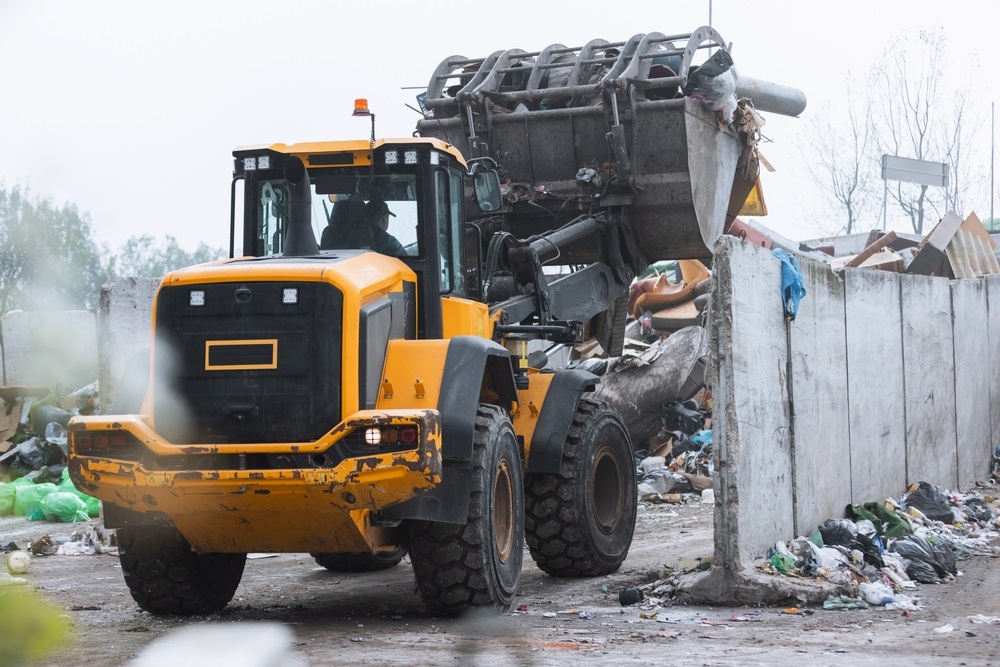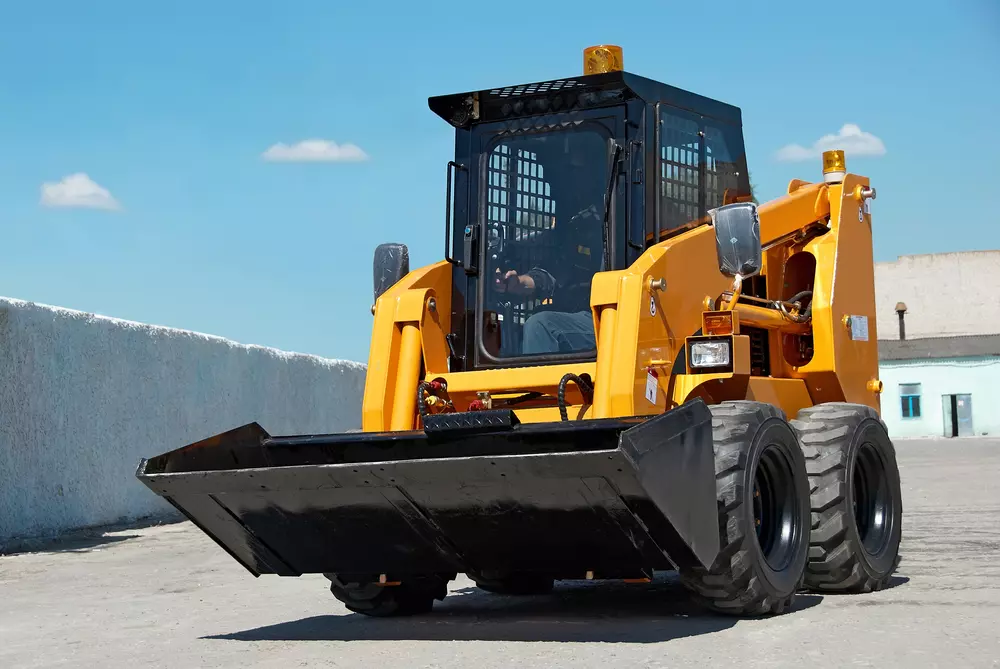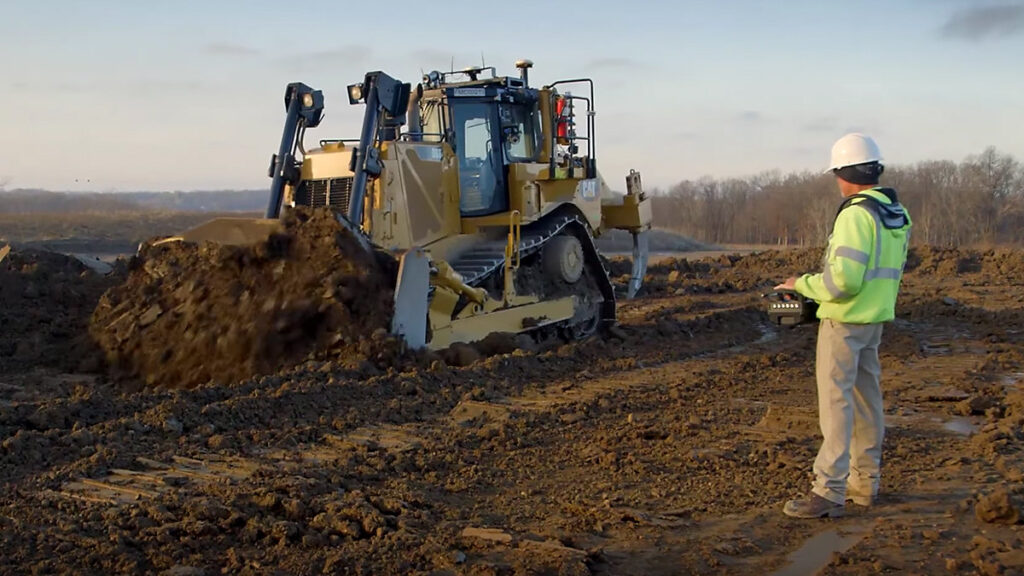A skid steer trench filler, especially when referencing Typhon Machinery’s offering, is an essential attachment for quick and efficient trench backfilling in construction and landscaping projects.
What Is a Skid Steer Trench Filler?
A skid steer trench filler is an attachment designed to fill trenches or ditches rapidly by scooping and depositing soil back into the trench. Typhon’s model features a bucket with a flat bottom and curved back, specifically engineered for adaptability to varying trench widths—a crucial advantage for dealing with multiple site conditions.
Key Features and Specifications
- Adjustable Width: Typhon’s trench filler offers an adjustable bucket, ensuring it matches every trench’s specifications for efficient filling.
- Effortless Operation: Operators simply position the skid steer at the trench, lower the attachment, and move forward. Soil and debris are scooped and deposited efficiently, minimizing manual labor.
- Compact Power: Typhon’s attachment is compact but robust, with dimensions around 1285 x 480 x 416mm and weighing 124kg, making it easy to maneuver while delivering reliable performance even in smaller spaces.
Advantages Over Manual and Other Methods
- Timesaving: Automated trench filling saves considerable time compared to manual methods, allowing crews to move through filling jobs more quickly.
- Reduced Labor Costs: The attachment streamlines the backfilling process, requiring only a single operator and drastically reducing the need for manual workers.
- Consistent Results: Adjustable depth and width settings enable precise filling, minimizing the risk of uneven trenches and settlement issues.
- Versatility: Typhon’s trench filler is suitable for both small-scale landscaping and larger construction tasks, thanks to its adaptable design and high-torque hydraulic motor compatibility.
- Enhanced Jobsite Safety: With more work done by machine and less by hand, there’s less physical risk to workers, which is especially important in challenging trenching conditions.
Usage Instructions
- Position the skid steer loader at one end of the trench.
- Lower the trench filler attachment into the trench.
- Drive the loader forward; the attachment scoops up and deposits the spoil for a smooth fill.
- Continue until the trench is completely filled.
Applications
Typhon’s skid steer trench filler is used for a wide range of projects:
- Utility line installation (water, gas, electrical)
- Landscape irrigation
- Road and driveway projects
- Small-area excavations for farms, gardens, parks, and public spaces.
Why Choose Typhon Machinery?
Typhon Machinery is known for reliable, easy-to-use heavy equipment and attachments. The trench filler stands out for its compact yet tough engineering, versatility, and labor-saving design, making it ideal for both contractors and landscapers seeking efficient trench backfilling solutions.
Outline for “Skid Steer Trench Filler”
| Section | SEO Angle |
|---|---|
| Introduction | Skid Steer Trench Filler: Maximize Efficiency, Minimize Labor |
| Features | Adjustable Trench Width & Effortless Operation |
| Benefits | Save Time, Cut Costs, Improve Safety |
| Applications | Landscaping, Utility, Construction, Irrigation |
| Typhon Advantages | Compact Power, User-Friendly, Versatile |
| How to Use | Simple 4-Step Operating Guide |
| Specifications | Bucket Size, Dimensions, Compatibility |
| Buying Guide | Why Typhon Is the Preferred Choice |
Utilize Typhon’s trench filler for reliable, consistent, and time-efficient trench backfilling across a range of job sites
features and benefits for the Typhon trench filler
The Typhon skid steer trench filler is engineered for swift, efficient, and effortless trench backfilling on construction and landscaping sites. This attachment features a bucket with a flat bottom and curved back, providing an adjustable width to perfectly match the specifications of different trenches, ensuring versatility for a wide range of projects.
Key Features
- Adjustable Design: Adaptable bucket width for compatibility with various trench sizes, enhancing operational flexibility.
- Effortless Operation: Simple mounting and use—just position, lower, and drive forward for seamless backfilling. The bucket efficiently scoops and deposits soil, creating a uniform fill as the loader advances.
- Rugged Build: Designed for durability under tough jobsite conditions, delivering reliable performance shift after shift.
Core Benefits
- Saves Time: Automates the backfilling process, allowing teams to finish jobs more quickly by eliminating the need for manual shoveling.
- Reduces Labor Costs: Minimal personnel required, lowering project expenses and freeing up crew for other critical tasks.
- Consistent Results: Ensures a smooth, even fill that minimizes the risk of future settling and enhances overall site safety.
- Versatile Utility: Perfect for construction, landscaping, and utility installation—making it a must-have for professionals who demand efficiency and adaptability.
The Typhon skid steer trench filler attachment delivers effortless, precise trench backfilling—maximizing productivity and results on every project.
Technical specifications for the Typhon trench filler
| Specification | Details |
|---|---|
| Model | Typhon Skid Steer Trench Filler |
| Dimensions (L x W x H) | Approx. 1285 x 480 x 416 mm |
| Weight | 124 kg |
| Bucket Width | Adjustable to fit varied trench widths |
| Bucket Type | Flat bottom, curved back |
| Compatibility | Fits most skid steer loaders |
| Operation | Hydraulic powered via skid steer |
| Application | Trench backfilling, landscaping, utility installation |
What is the depth of a skid steer trencher?
The depth of a skid steer trencher typically ranges from about 2 feet (24 inches) to 5 feet (60 inches), depending on the model and boom size. Common depth options available in the market include 36 inches, 48 inches, and 60 inches.
Many trenchers come with adjustable depth control systems that allow operators to set the trenching depth precisely according to project requirements. For example, popular skid steer trenchers have preset depth settings such as 24″, 30″, and 36″, or boom lengths that can be swapped to change the maximum digging depth.
This adjustable depth feature is essential for utility, landscaping, and construction tasks requiring narrow and accurately measured trenches.
Typical maximum digging depths for skid steer trenchers
Typical maximum digging depths for skid steer trenchers generally range between 36 inches (3 feet) and 60 inches (5 feet). Common maximum depths offered by many skid steer trencher attachments include 36″, 48″, and 60″.
These depths cover a wide range of project needs, from shallow irrigation and landscaping trenches to deeper utility line installations. Some models also offer adjustable boom lengths or depth controls to customize the digging depth precisely for different trenching applications, providing versatility on job sites.
How trench depth affects hydraulic flow requirements
Trench depth affects hydraulic flow requirements for skid steer trenchers because deeper trenches require more power to maintain consistent cutting performance and chain rotation. As trench depth increases, the hydraulic motor driving the trencher chain demands higher flow rates (measured in gallons per minute, GPM) to generate sufficient torque and cutting force.
- For standard flow skid steers (approximately 25–30 GPM), trenchers typically achieve depths up to 48 inches (4 feet). These flow rates are adequate for moderate trenching tasks.
- For higher trench depths (up to 5 feet or 60 inches), skid steers with high-flow hydraulics (above 30 GPM) are required to provide the increased hydraulic flow necessary to power larger trencher units with more torque.
- Hydraulic pressure (psi) also plays a role; typical pressures range between 2,500 to 3,500 psi for standard flow and up to 5,000 psi for high flow models.
- The combination of flow and pressure determines the trencher’s ability to cut efficiently under challenging conditions like dense soil or rocky terrain.
- Operators must match their skid steer’s hydraulic flow and pressure capabilities to the trencher size and desired trench depth to ensure optimal performance without stalling or overloading the hydraulic system.
In summary, deeper trenching requires higher hydraulic flow rates and pressures to deliver the power needed for effective digging, making the hydraulic capacity of the host skid steer critical in selecting the right trencher attachment
When to choose high-flow vs standard-flow trencher units
Choosing between high-flow and standard-flow trencher units depends on the hydraulic capacity of the skid steer loader and the nature of the trenching work:
Standard-Flow Trencher Units (around 20–30 GPM):
- Suitable for skid steers with lower hydraulic flow capabilities.
- Ideal for smaller to medium trenching jobs with depths typically up to 48 inches.
- Best for softer soils, less dense materials, and lighter applications such as irrigation, landscaping, or shallow utility trenches.
- Lower cost and less hydraulic demand, making them easier to operate on general-purpose skid steers.
High-Flow Trencher Units (above 30 GPM):
- Designed for skid steers equipped with high-flow hydraulic systems.
- Necessary for deeper trenching (up to 60 inches or more) and tougher ground conditions (rocky, compacted soil).
- Provide greater torque and faster digging speeds, enhancing productivity on demanding construction or utility projects.
- More suited for heavy-duty, continuous operations where reliability and power are critical.
In essence, standard flow trenchers are a cost-effective choice for moderate depth and softer soils, while high-flow units offer the power and durability needed for challenging, deeper trenching tasks. The skid steer’s hydraulic flow capability and the job requirements should guide the selection to optimize performance and equipment longevity.

